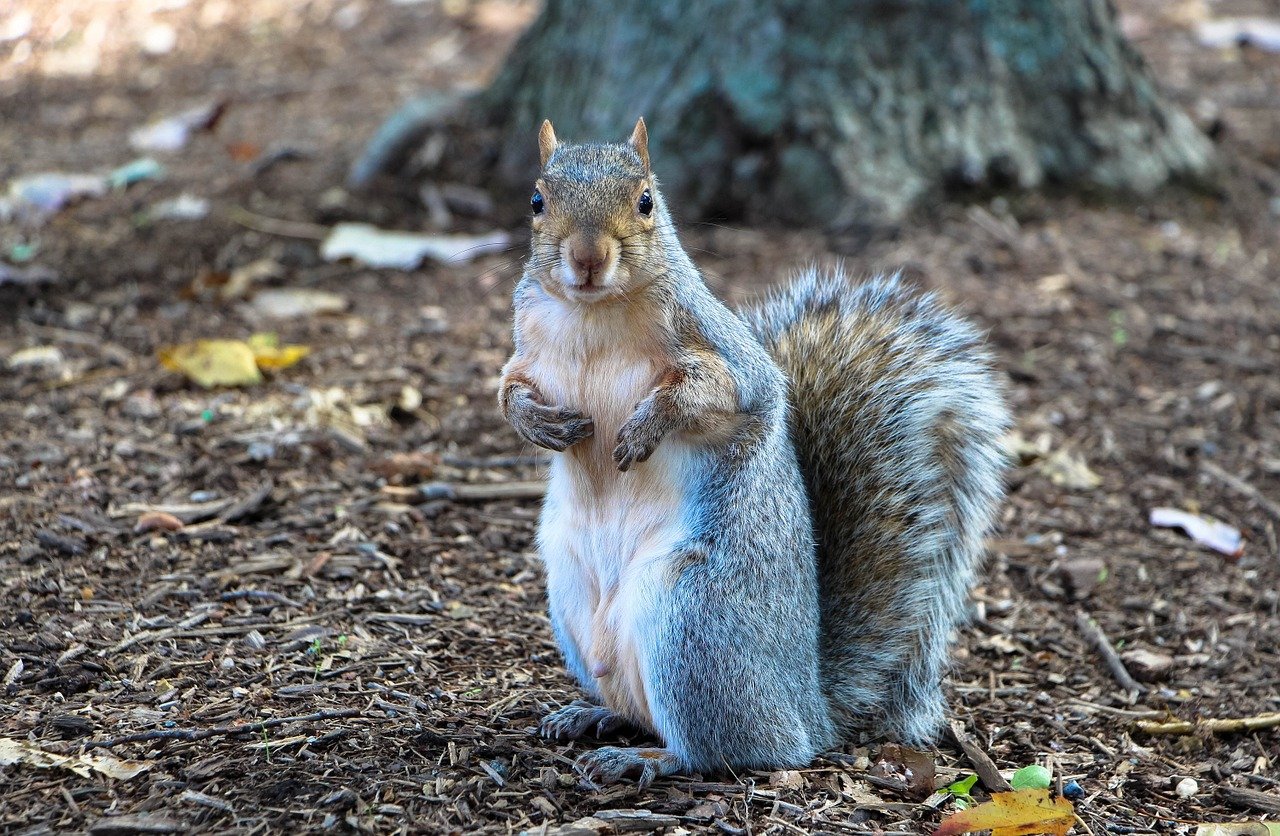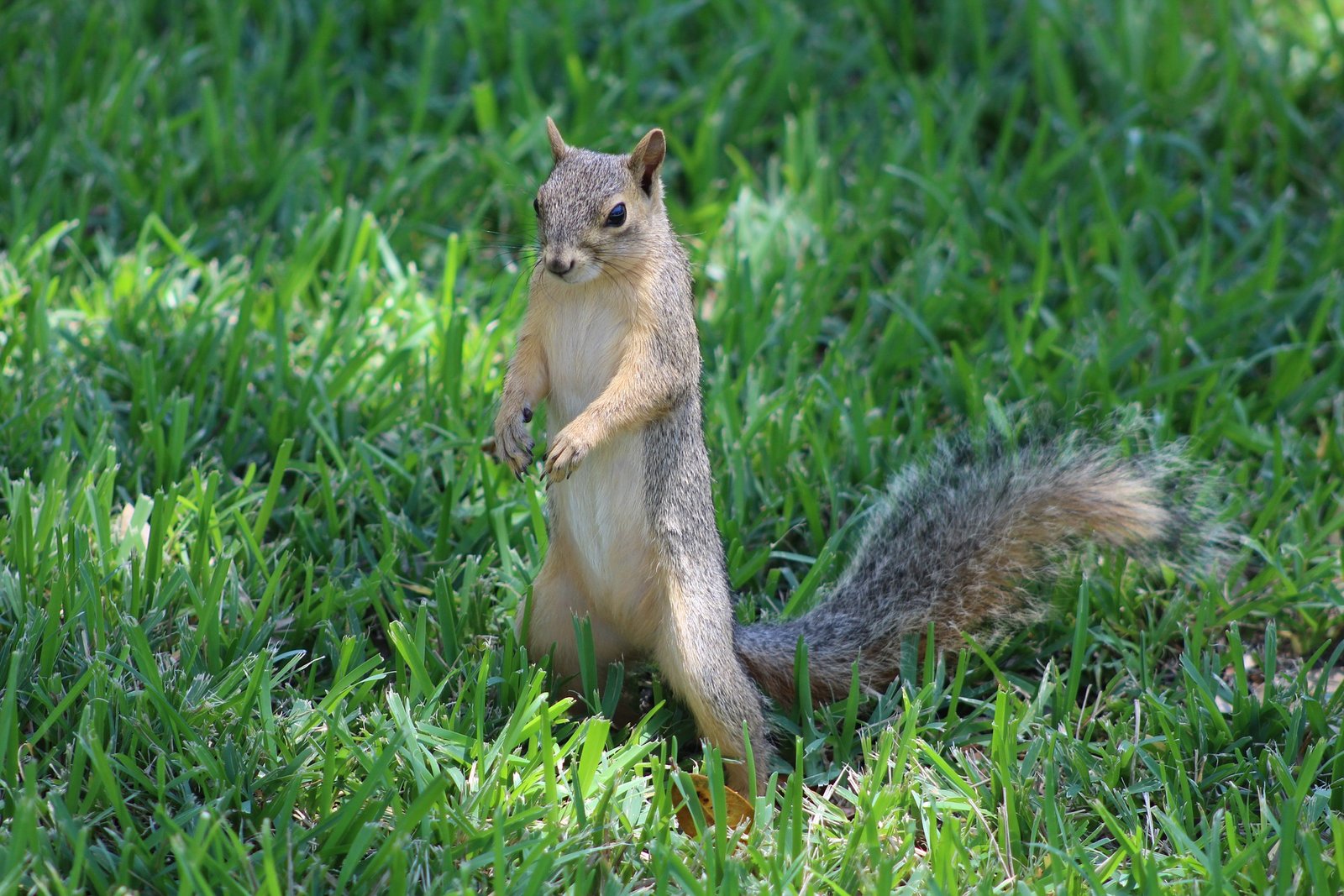Gray Squirrel: Sciurus Carolinensis

Description Of The Gray Squirrel
Medium-sized tree squirrels are grey squirrels. In size and color, males and females are similar. The back of the fur ranges from grizzled dark grey to pale grey and may have red tones. Their ears are white to pale grey, and they have white to pale grey tails. The underbody is grey to white as well.
In northern populations of this species, melanism is common. Some eastern gray squirrel populations are entirely melanistic, so all the squirrels in that region are black all over their whole body. If you see a black squirrel, the eastern grey squirrel is most likely to be melanistic. There are higher levels of albinism in some grey squirrel populations, which results in white fur, but this is very rare.
The squirrel’s total length ranges from 380 millimeters to 525 millimeters. Tail lengths vary between 150-250 mm.
By their white-tipped fur and white or grayish belly, you can tell gray squirrels apart from fox squirrels. In their fur, gray squirrels often have a lot of red. Fox squirrels have red-tipped bellies and red fur. Typically, Eastern grey squirrels are smaller than fox squirrels. In most parts of North America, completely black eastern gray squirrels are quite prevalent. There will not be white-tipped fur or white bellies for these black squirrels. In some parts of the southeastern United States, black fox squirrels are found. 1Go To Source biokids.umich.edu -“Eastern grey squirrel Sciurus carolinensis”
Learn More: Squirrel Pests In The United States
Gray Squirrel Behavior

Squirrels have a peak activity time of about 2 hours after sunrise and 2-5 hours before sunset during spring, summer, and autumn. This enables them to avoid the day’s heat. They are uniformly diurnal during the winter, with an activity peak just 2-4 hours before sunset.
Generally, in the summer months, females are more active, and males are more active in the winter months. During breeding times, a hierarchy of dominance forms in males; females mate with several males. Related individuals may defend a territory.
Two types of homes are occupied by squirrels, including a permanent tree den and a nest made of leaves and twigs on a tree branch 30-45 feet above the ground. When pregnant, females nest alone, and lactating females are particularly aggressive, and others avoid them. 2Go To Source animaldiversity.org -“Sciurus carolinensis eastern gray squirrel”
Reproduction Of Gray Squirrels
Gray squirrels have a polygynous (promiscuous) mating system. For the ability to mate with female Gray squirrels, males compete with each other. Females might also mate with more than one male in a single year.
Breeding occurs in December-February and May-June and, in more northern latitudes, is slightly delayed. The female bears her litter in a den or leafy nest after a gestation period of 40-44 days. Litter size ranges from 1 to 9 (average 2 or 3). Until they reach independence, young squirrels are cared for in the nest by their mother.
In the seventh week, weaning begins and is completed by the tenth week. At this point, the hair of juveniles is lost. At 9 months old, adult size and mass are achieved. At 1.25 years, most females start their reproductive life but can bear young as early as 5.5 months. At 11 months, males are usually able to breed. 3Go To Source animalia.bio -“EASTERN GRAY SQUIRREL”
Gray Squirrel Communication Methods
A significant element of squirrel communication is vocal signals; they fall into four main categories: nesting, mating, aggressive, and warning calls. To call their mother, baby squirrels use small cries, and a male squirrel chasing a woman during the mating season will use a series of calls that sound like sneezes to get her attention. A tiny, shrill scream will be released by a severely scared squirrel, while a squirrel under threat may warn each other with many sounds that vary depending on the danger or intrusion present in their territory.
Squirrels use scent to mark their territory, much like dogs, and leave clues for other squirrels that may wander by. By rubbing cheeks or scent glands on trees, they deposit scents, typically after gnawing on the bark or on exposed roots. The scents left behind by squirrels can indicate territorial boundaries, levels of stress, social hierarchies within the territory, and accessibility to reproduction. 4Go To Source animals.mom.com -“HOW SQUIRRELS COMMUNICATE WITH THEIR SPECIES”
Diet Of Gray Squirrels

The Gray squirrel’s main diet is composed of hard mast, wild berries, and fruit. Gray squirrels occasionally consume fungi, bird eggs or nestlings, and insects. Wild cherries, hickory nuts, oak acorns, tulip poplar tree cones, beechnuts, dogwood, and sassafras berries are late summer foods.
Squirrels do not hibernate, but they become less active in the winter to reduce the demand for energy in the winter. They will spend most of their time searching on the ground floor for previously buried acorns and nuts when they are active during the winter. Squirrels, by a sense of smell, not memory, discover buried nuts or caches. Gray squirrels will forage on early tree buds and spring seeds from February to May until spring greens’ emergence. 5Go To Source in.gov -“Gray Squirrel”
Gray Squirrel Habitat
Generally, gray squirrels are found both in mixed hardwood forests and in suburban or urban areas. White oak, American beech, American elm, red maple, and sweet gum are the trees most commonly used by gray squirrels.
Gray squirrels will often use old woodpecker holes or natural tree cavities to live and raise young. Gray squirrels will also build large nests made of leaves and twigs. Dens are generally manufactured at least 20 feet off the ground. Gray squirrels are often social and will share their nests during certain times of the year with other gray squirrels. 6Go To Source dnr.maryland.gov -“Maryland Mammals”
Range & Distribution Of Gray Squirrels
In the eastern United States, gray squirrels (Sciurus carolinensis) occur; the range extends west to the edge of the eastern deciduous forests of the U.S. and north to southern Quebec and Ontario.
Top 5 Predators Of The Gray Squirrel
Threats To The Gray Squirrel Species
Habitat loss and degradation, road-kill mortality, and disease are major threats to Washington’s western gray squirrel. Populations of eastern gray squirrels, fox squirrels, ground squirrels from California, and wild turkeys are expanding and may compete with western gray squirrel populations and negatively impact them. Competition with eastern gray squirrels could be a significant current problem for the population. 7Go To Source fws.gov -“Western Gray Squirrels”
Gray Squirrel Disease
A viral disease that generates multiple tumors on the skin of gray and fox squirrels is squirrel pox or squirrel fibroma. It belongs to the poxvirus group that produces rabbit fibromatosis, hare fibromatosis, rabbit myxomatosis, and certain deer fibromas.
In 1953, multiple skin tumors were reported on gray squirrels from Maryland. Since then, reports have come from Florida, New York, Virginia, Michigan, North Carolina, and Ontario about squirrels with skin tumors. 8Go To Source michigan.gov -“Squirrel Pox”
Sources:
- Lawniczak, M. 2002. “Sciurus carolinensis” (On-line), Animal Diversity Web. Accessed January 25, 2021 at http://www.biokids.umich.edu/accounts/Sciurus_carolinensis/
- Lawniczak, M. 2002. “Sciurus carolinensis” (On-line), Animal Diversity Web. Accessed January 25, 2021 at https://animaldiversity.org/accounts/Sciurus_carolinensis/
- “Eastern Gray Squirrel – Facts, Diet, Habitat & Pictures on Animalia.Bio.” Animalia, Animalia, animalia.bio/eastern-gray-squirrel. Accessed 25 Jan. 2021.
- Freeman, Margot. “How Squirrels Communicate With Their Species.” Animals – Mom.Com, 19 Nov. 2020, animals.mom.com/squirrels-communicate-species-5847.html.
- IN DNR. “DNR: Gray Squirrel.” Indiana Department Of Natural Resources, State Of Indiana, www.in.gov/dnr/fishwild/5689.htm. Accessed 25 Jan. 2021.
- “Eastern Gray Squirrel.” Maryland Department Of Natural Resources, State Of Maryland, dnr.maryland.gov/wildlife/Pages/plants_wildlife/easterngraysquirrel.aspx. Accessed 25 Jan. 2021.
- U.S. Fish and Wildlife Service. “Western Gray Squirrels | Fish and Wildlife Service.” U.S. Fish And Wildlife Service, Department of the Interior, 30 Aug. 2016, www.fws.gov/refuge/Conboy_Lake/Wildlife_and_Habitat/western_gray_squirrel.html#:%7E:text=Major%20threats%20to%20the%20western,impact%2C%20western%20gray%20squirrel%20populations.
- “DNR – Squirrel Pox.” Michigan The Department Of Natural Resources, State Of Michigan, www.michigan.gov/dnr/0,4570,7-350-79136_79608_85016-27274–,00.html#:%7E:text=Squirrel%20pox%2C%20or%20squirrel%20fibroma,fibromatosis%20and%20some%20deer%20fibromas. Accessed 25 Jan. 2021.
